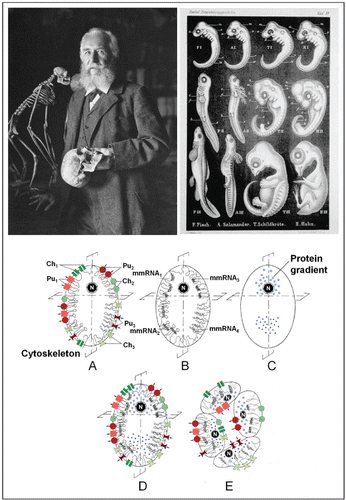Figures & data
Figure 1. The classical sender-receiver or communicating compartment (A) is a better alternative than the cell for functioning as the universal unit of structure and function of all living matter. Feedback is a spiral-like, unidirectional process (B). At bifurcation points, a choice has to be made as to how to proceed with communication. In digital-era wording, the Temple of Life has only 4 pillars (C), in contrast to the classical PICERAS Temple of Life that has 7.Citation18,19
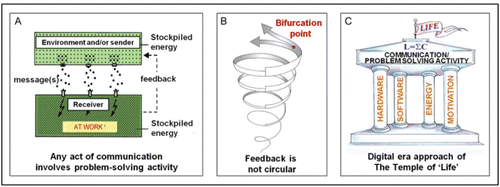
Figure 2. Cartoon illustrating my view that Life came into being at the very moment that the first act of communication was executed. Which act and under which environmental conditions this happened is unknown. Adapted from ref. Citation19.
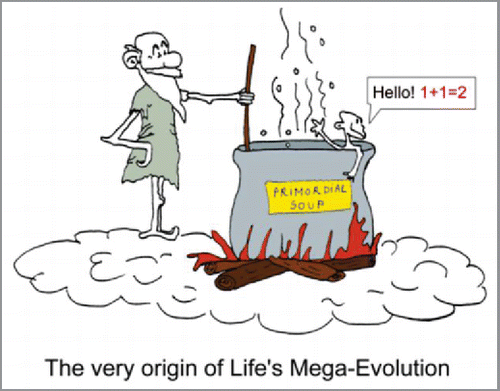
Figure 3. Self-generated electrical activity by cells. All cells generate an inorganic ion-based voltage difference over their plasma membrane. In resting conditions, the cytoplasmic side of the plasma membrane is at negative potential. The inorganic ion environment in the cytoplasm and (if present) in the nucleoplasm influences both gene expression and the still enigmatic cognitive memory system. Mechanisms exist that make that ion pumps and channels, the key actors instrumental to the ‘electrical dimension of cells’, do not float freely in the plane of the plasma membrane. Non-spherical symmetry can result. Under proper conditions, self-generated electrical currents traverse the cell. The current loops have to be closed outside the cell. Three examples of the electric field which surrounds a living entity are shown: an ameba, a plant and an animal embryo. They were measured with the vibrating probe technique of Jaffe and Nuccitelli.Citation36 For more examples see ref. Citation19.
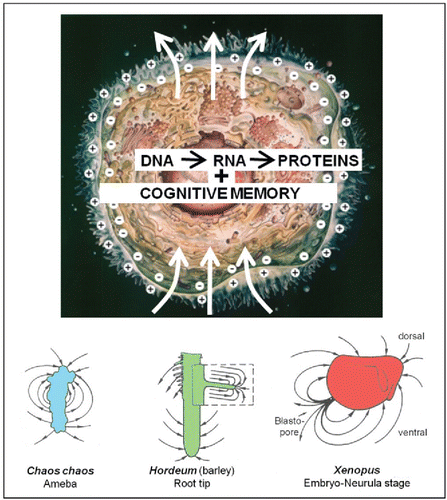
Figure 4. Major genetic and non-genetic causes of (Communicational) variability. Not only Charles Darwin, but his contemporary Alfred Russel Wallace as well, independently conceived the theory of evolution through natural selection. Jean-Baptiste Pierre Antoine de Monet, Chevalier de Lamarck (1744–1829) but commonly referred to as simply Lamarck is best known for his theory of inheritance of acquired characteristics that was proven wrong in the context of classical genetics (pictures from Wikipedia, with thanks). Epigenetics is a form of temporary transfer of genetic information (through DNA- and/or histone modification) to the next (few) generation(s). According to some researchers such transfer is Lamarckian in nature. Cultural evolution is also mainly Lamarckian in nature.
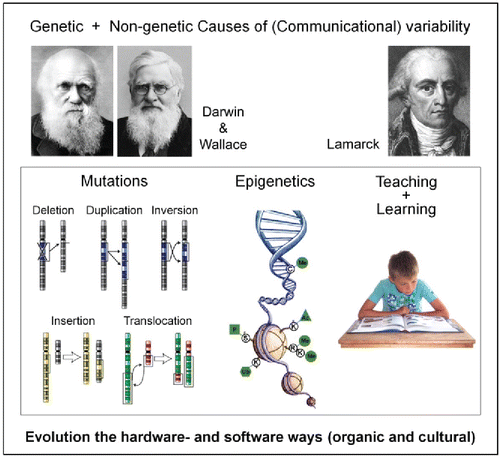
Figure 5. Development and evolution. Ernst Haeckel's ‘biogenetic law’Citation56 “Ontogeny recapitulates phylogeny,” although not perfect, strongly influenced the thinking about the relationship between development and evolution (pictures from Wikipedia, with thanks). It took until the second half of the 20th century before the molecular mechanisms underlying differentiation and development were gradually unraveled. The lower part of the figure illustrates the essence of the ‘double asymmetry principle’Citation3,54,55 as instrumental to governing differentiation during development. It reads: “Keep during the successive mitotic divisions the genome constant (thus no mutations), but change again and again the inorganic ionic as well as the macromolecular environment around the genes. Figures A-E illustrate the major mechanisms instrumental to generating functional asymmetry in the stem cell (zygote) of a hypothetical 4-celled, epithelially organized organism (animal) (A-E).Citation19 The black color of all nuclei is meant to indicate that the genome does not change during differentiation. It is differentially used. First, an asymmetric distribution is realized (i) of the plasma membrane-cytoskeletal complex (A: Pu1-Pu3 = 3 types of ion pumps; Ch1-Ch3 = 3 types of ion channels); (ii) and/or of maternal mRNAs (B: mmRNA1-mmRNA4, some of which can be anchored to the cytoskeleton; (iii) and/or of gradients of certain proteins in the cytoplasm/yolk (C) (e.g., of the bicoid and nanos gradients in eggs of Drosophila). Next the egg is cleaved in an asymmetric way. Sometimes this happens already during the first cleavage, but never later than during the third. In D, which represents the superposition of A, B, and C, it is the second cleavage which will give rise to 4 different cell types, all sharing the same genome (E). This part of the figure legend was copied from De Loof.Citation19
